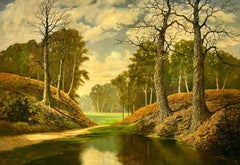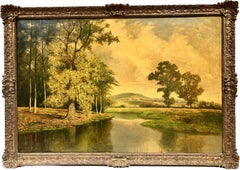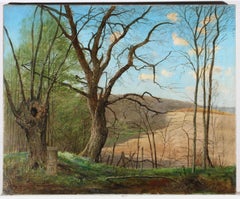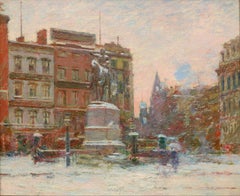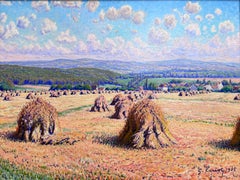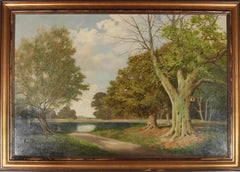This lovely British Victorian oil painting is by Edward Charles Williams of the Williams Family of artists and related to George Morland. The painting is a figurative landscape entitled the Woodman's family and entails five figures and a dog gathered around a tree that the Woodman is tackling with his axe. The painting is signed and indistinctly dated (only visible with ultra violent light) lower left, the date being 1869. For me, the highlight of the painting is the artistry and attention to detail with which Williams has portrayed the light on the trees above and the exquisite colouring of the leaves. There are even two birds finely depicted in the tree foliage.
Signed and indistinctly dated 1869 lower left (only visible under ultraviolet light).
Provenance. Berkshire estate.
Condition. Oil on canvas, image size is 40 inches by 36 inches and in good condition.
Housed in a complementary frame. Framed size is 48 inches by 44 inches and in good condition.
Edward Charles Williams (London 10 July 1807 – 25 July 1881) was an English landscape painter during the Victorian Era, and a member of the Williams family of painters. He was the eldest son of the painter Edward Williams (1781–1855) and Ann Hildebrandt (c.1780–1851), and a member of the Williams family of painters, who were related to such famous artists as James Ward RA and George Morland. His father was a well-known landscape artist, who taught him how to paint; otherwise he received no formal instruction. He adopted much of his father's style and technique, and like the other painters of his family, he devoted himself to landscapes, producing rich and tranquil views of Barnes, Cumberland, Kent, Surrey and the Thames. His paintings are now highly sought after. Williams married his first wife Mary Ann Challenger on 11 December 1839 in Westminster. Mary Ann died in 1857 in London, and his only child Alice Williams was born shortly afterwards to Sarah Susannah Horley, who had been Mary Ann's nurse – Edward and Sarah did not marry for another 10 years until 3 October 3, 1868, when they wed at the St. Pancras Old Church in Camden, London. He largely stopped painting after the 1859 death of his second wife, adding value to the small number of paintings that he did produce from 1859 on − Springer in the Bracken, The Lap Dog, The Ploughman's walk home, The Ducks at Tilbury and Primrose at St Mary's (Primrose was the Verger's Cat). Some suggest that he suffered a breakdown after his wife's death, given his choice of subjects in these later years. The location of three of these post-1859 works are unknown, and they are assumed lost during two world wars. He signed some of his work as E Williams, which leads to confusion with his father, who painted in a similar style, and at times he signed as C Williams to purposely avoid such confusion. Because many of the paintings of both father and son are unsigned, it can be difficult to correctly attribute their work. Edward Charles also collaborated on several paintings with William Shayer, where Williams would paint the landscape, and Shayer would add in figures and animals; his Near Wantage, Berkshire is a good example. He died 25 July 1881 at Shepherds Bush in London and is buried with Sarah Horley and their daughter Alice in Hammersmith Old Cemetery, close to other family graves. Edward Charles Williams was born into an artist family that is sometimes referred to as the Barnes School. His father and five surviving brothers were all noted landscape painters during the Victorian era. Three of the sons of Edward Williams changed their last names to protect the identity of their art. Edward Williams (father) Henry John Boddington, George Augustus Williams, Arthur Gilbert, Sidney Richard Percy,
Alfred Walter Williams.
